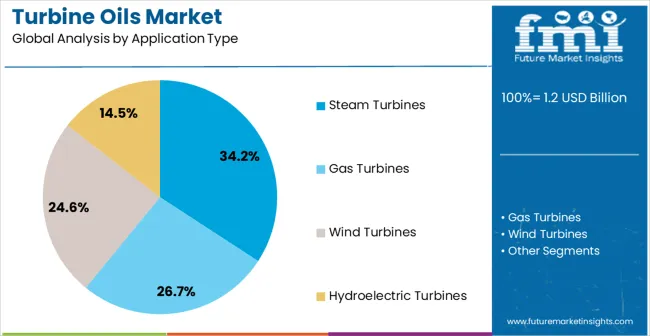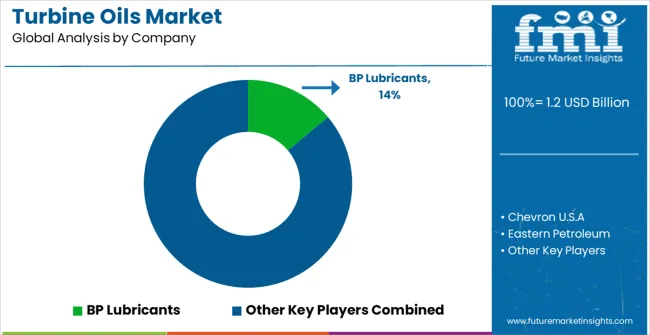The Turbine Oils Market is estimated to be valued at USD 1.2 billion in 2025 and is projected to reach USD 2.8 billion by 2035, registering a compound annual growth rate (CAGR) of 8.8% over the forecast period.

| Metric | Value |
|---|---|
| Turbine Oils Market Estimated Value in (2025 E) | USD 1.2 billion |
| Turbine Oils Market Forecast Value in (2035 F) | USD 2.8 billion |
| Forecast CAGR (2025 to 2035) | 8.8% |
The Turbine Oils market is experiencing steady expansion, driven by the growing demand for reliable lubrication solutions that enhance turbine efficiency, extend equipment life, and reduce maintenance costs. Turbine oils play a crucial role in ensuring smooth operation of turbines by providing oxidation stability, corrosion protection, and thermal resistance under high-stress environments. Increasing investments in energy infrastructure, particularly in power generation facilities, are accelerating adoption, as turbines form a critical part of both renewable and conventional power systems.
Technological advancements in turbine oil formulations, including the incorporation of synthetic additives and improved base oils, are enabling superior performance and longer drain intervals, reducing operational costs for end users. Rising demand for uninterrupted power supply, coupled with rapid industrialization in developing economies, is further boosting consumption.
Growing emphasis on reducing downtime and improving turbine efficiency has also reinforced the need for high-performance oils As global energy demand continues to rise, the Turbine Oils market is expected to maintain consistent growth, supported by modernization of energy systems and increased reliance on durable lubrication solutions.
The turbine oils market is segmented by product type, application type, and geographic regions. By product type, turbine oils market is divided into Mineral Oil-Based Turbine Oils and Synthetic Oil-Based Turbine Oils. In terms of application type, turbine oils market is classified into Steam Turbines, Gas Turbines, Wind Turbines, and Hydroelectric Turbines. Regionally, the turbine oils industry is classified into North America, Latin America, Western Europe, Eastern Europe, Balkan & Baltic Countries, Russia & Belarus, Central Asia, East Asia, South Asia & Pacific, and the Middle East & Africa.

The mineral oil-based turbine oils segment is projected to hold 54.7% of the market revenue in 2025, making it the leading product type. This dominance is being driven by the widespread availability, cost-effectiveness, and proven performance of mineral oil-based formulations. These oils provide essential lubrication and oxidation stability, ensuring reliable turbine performance across diverse operating conditions.
Their compatibility with existing turbine systems and ease of use have made them a preferred choice for power plants and industrial users worldwide. Advancements in refining technologies have enhanced the purity and stability of mineral oil-based turbine oils, further improving their performance. Additionally, their affordability compared to synthetic alternatives continues to reinforce strong demand, particularly in price-sensitive markets.
The large installed base of turbines globally supports the continued reliance on mineral oil-based solutions As industries seek reliable and economical turbine lubrication options, the segment is expected to retain its leadership position, driven by its established market presence, consistent quality, and broad acceptance across applications.

The steam turbines segment is anticipated to account for 34.2% of the market revenue in 2025, establishing it as the leading application type. Growth is being supported by the continued reliance on steam turbines in power generation, particularly in thermal and nuclear plants, as well as in industrial operations requiring high-capacity energy output. Turbine oils are critical in these applications, ensuring smooth operation by reducing wear, preventing corrosion, and enhancing thermal stability under high pressure and temperature conditions.
The rising demand for uninterrupted power supply and modernization of power plants are driving the use of turbine oils in steam turbine systems. Furthermore, growing investments in expanding electricity generation capacity in developing economies are increasing adoption.
The ability of turbine oils to extend service intervals and reduce operational downtime in steam turbine systems reinforces their importance As the global power sector evolves with a balance of renewable and conventional energy sources, the steam turbines segment is expected to maintain its leadership, supported by its central role in large-scale power production.
Primary use of turbine oils has been as lubricants for turbine applications. Existing generation of turbine oils comprise high quality-base stocks. They possess a long anti-oxidation life, and considerably restrict rusting of the equipment even at high temperatures. Some of the turbine oils contain additives used for reduction of wear & tear, thereby contributing to longer life of the equipment.
Turbine oils are oils of high quality with excellent water-separating properties. Conventional turbine oils were mineral based, and were maintained to eliminate external contamination & oxidation products. In recent times, development of environmentally friendly bio-based turbine oils are anticipated to witness relatively faster growth in penetration, especially in Europe and in North America.
Also, use of bio-based turbine oils has been reported to be relatively more economical, as less concentration of oil is required as compared to conventional metalworking fluids. Also, these types of turbine oils display exceptional oxidation & thermal stability, and superior anti-wear properties. Besides, there has been an increasing focus on application of turbine oils as a substitute for rock drill and air tool lubricants for pneumatic applications.
This is so because the conventionally used rock drill and air tool lubricants usually comprise high pressure material fatty oils and fatty acids which are easily oxidized and degraded.
This disadvantage can be eliminated by using turbine oils, which have relatively superior properties & hence, do not adversely affect component parts, tubing & seals. Considering these important aspects of applications of turbine oils, the study of the turbine oils market becomes an important read.

| Country | CAGR |
|---|---|
| China | 11.9% |
| India | 11.0% |
| Germany | 10.1% |
| Brazil | 9.2% |
| USA | 8.4% |
| UK | 7.5% |
| Japan | 6.6% |
The Turbine Oils Market is expected to register a CAGR of 8.8% during the forecast period, exhibiting varied country level momentum. China leads with the highest CAGR of 11.9%, followed by India at 11.0%. Developed markets such as Germany, France, and the UK continue to expand steadily, while the USA is likely to grow at consistent rates. Japan posts the lowest CAGR at 6.6%, yet still underscores a broadly positive trajectory for the global Turbine Oils Market. In 2024, Germany held a dominant revenue in the Western Europe market and is expected to grow with a CAGR of 10.1%. The USA Turbine Oils Market is estimated to be valued at USD 424.4 million in 2025 and is anticipated to reach a valuation of USD 424.4 million by 2035. Sales are projected to rise at a CAGR of 0.0% over the forecast period between 2025 and 2035. While Japan and South Korea markets are estimated to be valued at USD 61.0 million and USD 36.1 million respectively in 2025.

| Item | Value |
|---|---|
| Quantitative Units | USD 1.2 Billion |
| Product Type | Mineral Oil-Based Turbine Oils and Synthetic Oil-Based Turbine Oils |
| Application Type | Steam Turbines, Gas Turbines, Wind Turbines, and Hydroelectric Turbines |
| Regions Covered | North America, Europe, Asia-Pacific, Latin America, Middle East & Africa |
| Country Covered | United States, Canada, Germany, France, United Kingdom, China, Japan, India, Brazil, South Africa |
| Key Companies Profiled | BP Lubricants, Chevron USA, Eastern Petroleum, Eastman Chemical Company, Exxon Mobil Corporation, FUCHS, Idemitsu, Indian Oil Corporation, Kluber Lubrication, Lubrizol, LUKOIL Marine Lubricants, NYCO, and Paras Lubricants |
The global turbine oils market is estimated to be valued at USD 1.2 billion in 2025.
The market size for the turbine oils market is projected to reach USD 2.8 billion by 2035.
The turbine oils market is expected to grow at a 8.8% CAGR between 2025 and 2035.
The key product types in turbine oils market are mineral oil-based turbine oils and synthetic oil-based turbine oils.
In terms of application type, steam turbines segment to command 34.2% share in the turbine oils market in 2025.






Our Research Products

The "Full Research Suite" delivers actionable market intel, deep dives on markets or technologies, so clients act faster, cut risk, and unlock growth.

The Leaderboard benchmarks and ranks top vendors, classifying them as Established Leaders, Leading Challengers, or Disruptors & Challengers.

Locates where complements amplify value and substitutes erode it, forecasting net impact by horizon

We deliver granular, decision-grade intel: market sizing, 5-year forecasts, pricing, adoption, usage, revenue, and operational KPIs—plus competitor tracking, regulation, and value chains—across 60 countries broadly.

Spot the shifts before they hit your P&L. We track inflection points, adoption curves, pricing moves, and ecosystem plays to show where demand is heading, why it is changing, and what to do next across high-growth markets and disruptive tech

Real-time reads of user behavior. We track shifting priorities, perceptions of today’s and next-gen services, and provider experience, then pace how fast tech moves from trial to adoption, blending buyer, consumer, and channel inputs with social signals (#WhySwitch, #UX).

Partner with our analyst team to build a custom report designed around your business priorities. From analysing market trends to assessing competitors or crafting bespoke datasets, we tailor insights to your needs.
Supplier Intelligence
Discovery & Profiling
Capacity & Footprint
Performance & Risk
Compliance & Governance
Commercial Readiness
Who Supplies Whom
Scorecards & Shortlists
Playbooks & Docs
Category Intelligence
Definition & Scope
Demand & Use Cases
Cost Drivers
Market Structure
Supply Chain Map
Trade & Policy
Operating Norms
Deliverables
Buyer Intelligence
Account Basics
Spend & Scope
Procurement Model
Vendor Requirements
Terms & Policies
Entry Strategy
Pain Points & Triggers
Outputs
Pricing Analysis
Benchmarks
Trends
Should-Cost
Indexation
Landed Cost
Commercial Terms
Deliverables
Brand Analysis
Positioning & Value Prop
Share & Presence
Customer Evidence
Go-to-Market
Digital & Reputation
Compliance & Trust
KPIs & Gaps
Outputs
Full Research Suite comprises of:
Market outlook & trends analysis
Interviews & case studies
Strategic recommendations
Vendor profiles & capabilities analysis
5-year forecasts
8 regions and 60+ country-level data splits
Market segment data splits
12 months of continuous data updates
DELIVERED AS:
PDF EXCEL ONLINE
Wind Turbine Market Analysis and Insights - 2025 to 2035
Turbine Blade Material Market Size and Share Forecast Outlook 2025 to 2035
Turbine Inlet Cooling System Market Growth - Trends & Forecast 2025 to 2035
Turbine Governor Market
Gas Turbine Oil Market Size and Share Forecast Outlook 2025 to 2035
Gas Turbine Service Market Size and Share Forecast Outlook 2025 to 2035
Lip Oils Market Size and Share Forecast Outlook 2025 to 2035
Gas Turbine Market - Size, Share, and Forecast 2025 to 2035
EDM Oils/Fluids Market
Wind Turbine Blade Market Size and Share Forecast Outlook 2025 to 2035
Wind Turbine Forging Market Size and Share Forecast Outlook 2025 to 2035
Wind Turbine Pitch and Yaw Drive Market Size and Share Forecast Outlook 2025 to 2035
Wind Turbine Industry Analysis in Latin America Growth - Trends & Forecast 2025 to 2035
Microturbines Market Growth – Trends & Forecast 2025 to 2035
Wind Turbine Automation Market Insights - Growth & Forecast through 2035
Wind Turbine Composite Material Market Size 2024-2034
Wind Turbine Blade Repair Material Market Growth – Trends & Forecast 2024-2034
Wind Turbine Shaft Market
Blown oils Market Size and Share Forecast Outlook 2025 to 2035
Steam Turbine Market Size and Share Forecast Outlook 2025 to 2035

Thank you!
You will receive an email from our Business Development Manager. Please be sure to check your SPAM/JUNK folder too.
Chat With
MaRIA